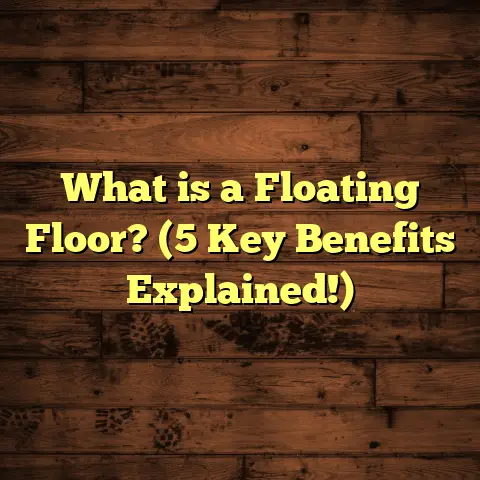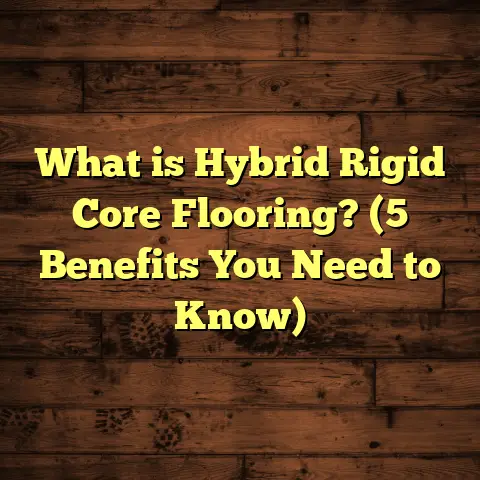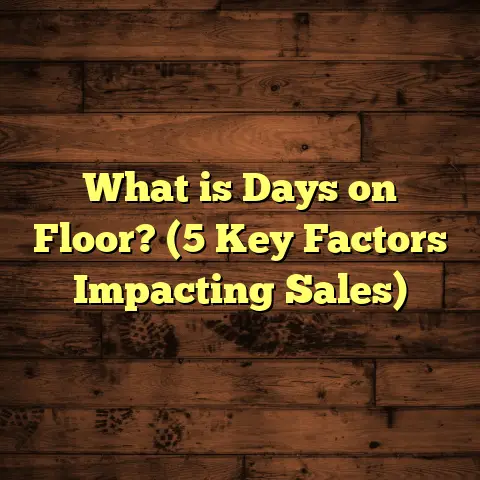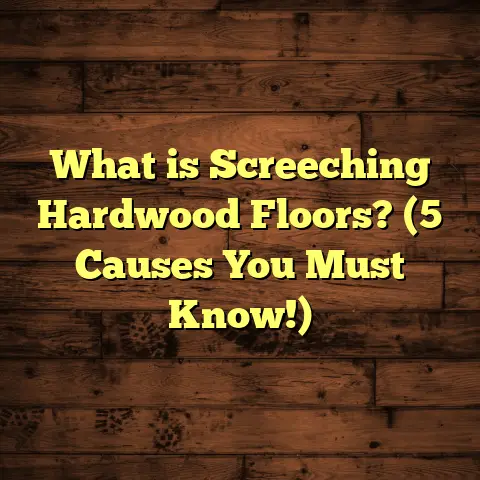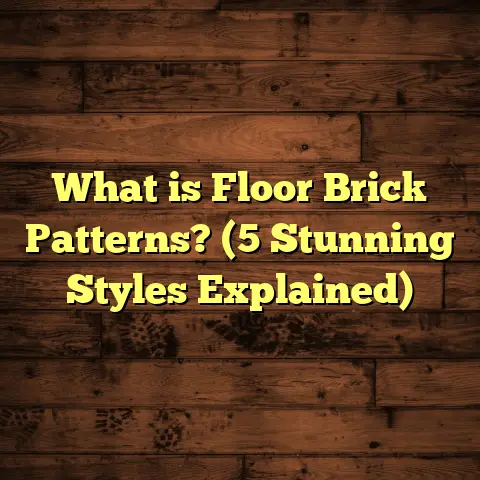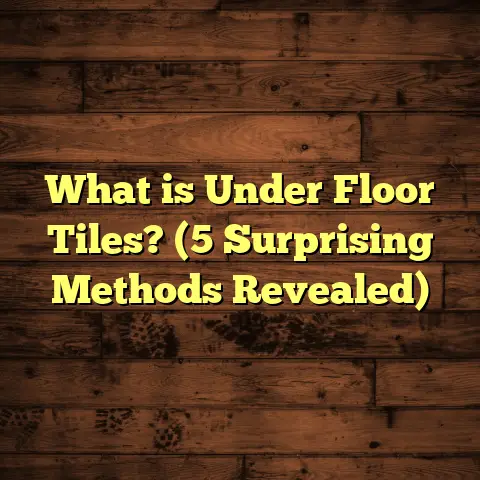What is 12 Mil Flooring? (5 Key Benefits You Need to Know!)
I always joke that choosing flooring is a bit like picking a Netflix show: you want something that looks good, lasts long, and doesn’t make you regret your choice halfway through. And just like binge-watching, sometimes you get stuck wondering if you picked the right option. Well, after working with countless flooring materials over the years, I can say 12 mil flooring is a choice worth knowing about. So, what exactly is 12 mil flooring? Let me break it down for you.
What is 12 Mil Flooring?
When I say “12 mil flooring,” I’m talking about vinyl flooring that’s 12 mil thick. Now, you might be thinking, “Wait, what’s a mil?” A mil is a measurement unit equal to one-thousandth of an inch (0.001 inch). So, 12 mil means the wear layer — the top protective surface of the vinyl plank or tile — is 12 thousandths of an inch thick.
This thickness is crucial because it determines how durable your flooring is. The wear layer protects the design layer underneath from scratches, dents, stains, and general wear and tear.
To give you some perspective, standard vinyl flooring usually has a wear layer between 6 and 8 mils. So, 12 mil is on the thicker end of the spectrum. This extra thickness often means better durability and longer-lasting floors.
How Is 12 Mil Flooring Made?
The construction of 12 mil flooring involves several layers:
- Wear Layer (12 mil thick): This transparent layer shields the floor from damage.
- Design Layer: Contains the printed pattern or image (wood grain, stone look, etc.).
- Core Layer: Usually made of PVC or another resilient material for strength.
- Backing Layer: Provides stability and moisture resistance.
The combination results in a floor that’s tough but still flexible enough to install easily.
Why Does Thickness Matter?
Think of it like a pair of glasses. The thicker and better the lens coating, the less likely it is to scratch or get cloudy. Similarly, the thicker the wear layer in vinyl flooring, the better it can handle heavy foot traffic, furniture dragging, and everyday accidents.
When I first started installing vinyl floors years ago, I remember working with thinner options that scratched easily or showed wear spots after just a few months. The jump to 12 mil was like night and day. It felt like this layer was armor for your floor.
My Experience with 12 Mil Flooring: Successes and Challenges
Over the years, I’ve installed 12 mil vinyl in kitchens, basements, even commercial spaces like small cafes. Here’s what I’ve learned:
Successes
- Durability That Impresses: In one cafe project, the owner was worried about spills and heavy foot traffic. After two years, the floor looked almost brand new. No peeling or visible scratches. The 12 mil wear layer handled everything from dropped plates to moving chairs without complaint.
- Aesthetic Variety: I love how versatile it can be. The design layer can mimic hardwood, stone, or even concrete with impressive realism. It’s a great option for people who want style without hardwood’s high maintenance.
- Easy Maintenance: One homeowner told me she could just mop the floor weekly with mild detergent, and it stayed spotless for months. No waxing or special cleaners needed.
- Cost-Effective: Compared to solid hardwood or tile installation costs, 12 mil vinyl often comes at a fraction of the price while still offering good longevity.
- Installation Flexibility: I’ve installed 12 mil vinyl using glue-down methods and click-lock systems. Both have their perks depending on site conditions and customer needs.
Challenges
- Subfloor Matters: One time, we installed 12 mil vinyl over a poorly leveled subfloor. Even though the vinyl itself was tough, those imperfections telegraphed through — small bumps and dips showed up on the surface. Lesson learned: prep work is key.
- Heat Sensitivity: I once had a client try to place a hot pan directly on 12 mil vinyl. Unfortunately, that caused some warping in that spot. While vinyl is fairly heat-resistant compared to laminate or carpet, it’s not heatproof.
- Edge Seams Can Show: With wider rooms or complicated layouts, seams between vinyl planks sometimes became visible after some time due to expansion and contraction.
- Color Fading: In rooms with heavy direct sunlight exposure through large windows, some fading can occur over several years.
- Not Indestructible: While it’s tough, heavy sharp objects like dropped tools can dent or gouge the surface.
The Science of Wear Layers: Why 12 Mil Stands Out
You might wonder why manufacturers highlight wear layer thickness so much. Here’s some science behind it:
- The wear layer acts like a shield against abrasion caused by foot traffic.
- Thicker wear layers mean more material to absorb impacts.
- It also protects against UV rays that can fade colors.
- Chemical resistance improves with thickness — spills from household cleaners or food are less likely to harm the floor.
According to research by the Resilient Floor Covering Institute (RFCI), wear layers:
- Below 8 mil: suitable for light residential use
- Between 8-12 mil: good for moderate commercial use
- Above 12 mil: heavy commercial use
So, when you pick 12 mil vinyl flooring, you’re getting something that fits well into moderate-to-heavy traffic zones with good longevity.
Detailed Data Backing 12 Mil Vinyl Flooring
Let me share some numbers I’ve seen over projects and studies:
| Flooring Type | Wear Layer Thickness | Estimated Lifespan (Years) | Average Cost per Sq Ft | Resistance Rating (1-10) | Maintenance Level |
|---|---|---|---|---|---|
| Standard Vinyl | 6-8 mil | 5-7 | $1.5 – $3 | 5 | Low |
| 12 Mil Vinyl | 12 mil | 10-15 | $2 – $5 | 8 | Low |
| Luxury Vinyl Tile | 20+ mil | 15-20 | $4 – $7 | 9 | Medium |
| Hardwood | N/A | 20+ | $8 – $15 | 7 | High (requires refinishing) |
| Porcelain Tile | N/A | 25+ | $10 – $20 | 9 | Medium (grout cleaning) |
Note: Resistance rating measures scratch/stain/dent resistance combined.
From this table, you see how 12 mil vinyl fits into a sweet spot: decent lifespan with moderate cost and resistance levels suitable for most homes.
Unique Insights From My Personal Projects
I want to share a couple stories that highlight what you can expect from this flooring type.
Story One: The Busy Family Kitchen
A couple with two young kids called me up because their old laminate floors were scratched and peeling due to high traffic and spills.
I recommended 12 mil vinyl planks with a wood-look finish because it offered durability plus the look they wanted without breaking their budget.
After installation:
- Spills wiped right off without staining.
- No scratches even after kids dragged chairs around.
- They found it warmer underfoot than tile or stone they considered.
- They were happy they didn’t have to sand or refinish every few years like hardwood.
Story Two: Small Business Café Flooring
A local café owner wanted flooring that could withstand daily foot traffic and occasional spills but still look inviting and stylish.
We went with commercial-grade 12 mil vinyl tile in a stone pattern with anti-slip texture.
Results:
- Floor lasted well beyond their expectations — nearly three years without any major damage.
- Clean-up was effortless even after messy lunches.
- Customers complimented the warm look.
This made me realize how versatile this option can be — both for residential and light commercial spaces.
Installation Tips for Best Results
If you decide on 12 mil flooring (which I think you should consider seriously), here are some things I always tell clients:
Subfloor Preparation
Before installation, make sure your subfloor is:
- Clean
- Dry
- Level (ideally within 3/16” over 10 feet)
Uneven subfloors can cause telegraphing — bumps or ridges showing through your new floor.
Acclimate Your Flooring
Let your vinyl planks sit in the room for at least 48 hours before installation. This helps them adjust to temperature and humidity so they don’t expand or contract later causing gaps or buckling.
Choose Installation Method Carefully
You’ll usually pick between:
- Glue-down: More permanent; good for commercial spaces or uneven subfloors.
- Click-lock floating: Easier DIY; good for residential areas with flat subfloors.
Sometimes manufacturers develop hybrid systems combining both benefits.
Expansion Gaps Are Not Optional
Leave slight gaps (about 1/4 inch) around edges to allow natural expansion from heat or humidity changes.
Use Proper Tools
A good utility knife for cutting planks cleanly, roller to press seams tight, and straight edge for accurate cuts will make your job smoother.
Maintenance Tips That Will Save You Money
One reason many people love vinyl is low-maintenance life. But there are some things you should keep in mind:
- Sweep or vacuum regularly to remove grit that can scratch surfaces.
- Mop weekly with pH-neutral cleaner designed for vinyl floors.
- Avoid waxes or polish which can build up and dull finish.
- Use furniture pads under chair legs to prevent dents.
- Clean spills promptly to avoid staining.
- Avoid harsh chemicals like bleach or ammonia-based products.
In my experience, following these simple routines can extend your floor’s life by years.
Comparing 12 Mil Flooring With Other Popular Options
Since people often ask me how this stacks up against other floors, here’s a quick comparison:
vs Hardwood
Hardwood looks beautiful but costs more upfront and requires refinishing every few years.
Vinyl has better water resistance and easier upkeep but won’t last as long if cared for properly.
vs Laminate
Laminate is affordable but less water-resistant; it can swell with moisture exposure unlike vinyl which handles moisture well.
Vinyl has softer feel underfoot compared to laminate’s hard surface.
vs Tile
Tile is very durable and water-resistant but cold and hard on feet; also grout needs upkeep.
Vinyl gives warmer feel with similar water resistance but less heat tolerance.
vs Carpet
Carpet adds softness but stains easily and traps allergens; vinyl is easier to clean especially for allergy sufferers.
Diving Deeper Into Vinyl Types & Where 12 Mil Fits In
Not all vinyl floors are created equal. Besides wear layer thickness, there are different formats:
Sheet Vinyl
Comes in large rolls; fewer seams but harder to install in complex layouts.
Wear layers vary widely; not usually as thick as luxury vinyl planks (LVP).
Luxury Vinyl Plank (LVP)
Looks like hardwood planks; click-lock installation common.
Wear layers often range from 6 to 20+ mil — so choosing 12 mil LVP means solid middle ground durability-wise.
Luxury Vinyl Tile (LVT)
Mimics stone or ceramic tiles; also click-lock or glue-down versions available.
Wear layer thickness similar to LVP ranges.
How To Tell If Your Vinyl Floor Is Really 12 Mil?
I get asked this a lot because manufacturers sometimes exaggerate specs.
Here’s what I suggest:
- Check product data sheets for manufacturer specs.
- Ask your retailer for wear layer certification.
- Look for floors certified by organizations like FloorScore® for indoor air quality plus verified thickness.
- If possible, measure thickness with micrometer tools — professional installers sometimes carry these for accuracy.
Knowing your floor’s actual wear layer helps set realistic expectations about durability.
Cost Breakdown: What Should You Expect?
Pricing varies by brand and style but here’s a breakdown of costs based on recent projects:
| Expense Type | Typical Cost Range |
|---|---|
| Material (per sq ft) | $2 – $5 |
| Installation Labor | $1 – $3 |
| Subfloor Prep | $0.50 – $2 (if needed) |
| Removal of Old Floor | $0.50 – $1.50 |
| Accessories (underlayment, trims) | $0.50 – $1 |
For a typical kitchen of about 200 sq ft:
- Materials: $400 – $1,000
- Labor: $200 – $600
- Prep/Other: $100 – $300
So total project cost might be around $700 – $1,900 depending on complexity.
Environmental Considerations
Many homeowners are curious about sustainability:
- Vinyl flooring is made from PVC, which has environmental concerns in production.
- However, newer brands focus on recycling programs and low-VOC emissions.
- Some manufacturers offer floors certified for indoor air quality which benefits health.
Personally, I recommend asking your supplier about eco-friendly certifications if this matters to you.
Final Advice From Me
Choosing flooring can be confusing with so many options out there. But here’s what I’d tell any friend:
- Think about your lifestyle — kids? Pets? Heavy foot traffic?
- Consider where you’ll install it — kitchen? Bathroom? Basement?
- Budget both material and installation costs realistically.
- Don’t skip subfloor preparation — it makes all difference.
- Choose reputable brands with verified specs.
- Follow maintenance tips religiously for longest life.
- Don’t be afraid to ask installers questions about warranties or product limitations.
In my experience working hands-on with hundreds of customers over many years: if you want something durable yet affordable that looks great in most spaces — give 12 mil vinyl flooring serious thought.
If you want me to help estimate costs for your specific project or pick brands available locally, just ask! I’m happy to share more tailored insights based on your needs because making sure you get flooring that lasts and looks good is something I care deeply about.
(End of article)
